Storyboard Designer offers many features to assist with the efficient development of your embedded user interface. Some of these features improve performance by reducing potential runtime inefficiencies while other features speed the development of the application by providing greater insight into an existing design or allowing multiple designers to work in parallel on the application's user interface.
The Design Notes export wizard is used to generate an HTML or PDF report of the storyboard project.
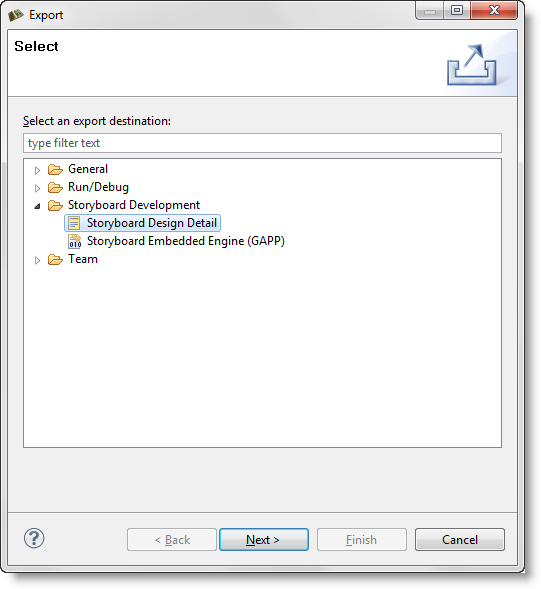
The Design Note export can be accessed from the File > Export > Storyboard Design Notes menu selection or by right clicking on a Storyboard GDE file and selecting Export Storyboard Design Notes. This will open a dialog allowing the user to select the filesystem location for the design report and the format, HTML or PDF, that the design report should be exported to.
The design notes contain information about each of the screens that are present in the application, the layer contents of those screens, the variables present in the application and the model elements to which they are associated. As much as it is possible to infer, a screen flow diagram is also created indicating which events trigger screen transitions.
It also possible to generate headless Design Note exports from the Storyboard Design files that can be used from a command line or scripting environment.
PATH_TO_INSTALL/Storyboard_Designer/storyboard/Storyboard -application com.crank.gdt.designreport.designreport model=PATH_TO_GDE_MODEL format=[pdf|html] output=PATH_TO_OUTPUT_FILE
Where
the model is the full path to the Storyboard Designer model
file and the output paramenter specifies the filesystem path
where the report and associated resources will be created. The
format parameter can be set to either html or
pdf to indicate HTML or PDF outputs respectively.
The GoTo dialog provides a quick way to locate and navigate to items in the application design. The GoTo dialog is activated when the CTRL+1 (Windows/Linux) or COMMAND+1 (Mac) keys are pressed while working in the main editor
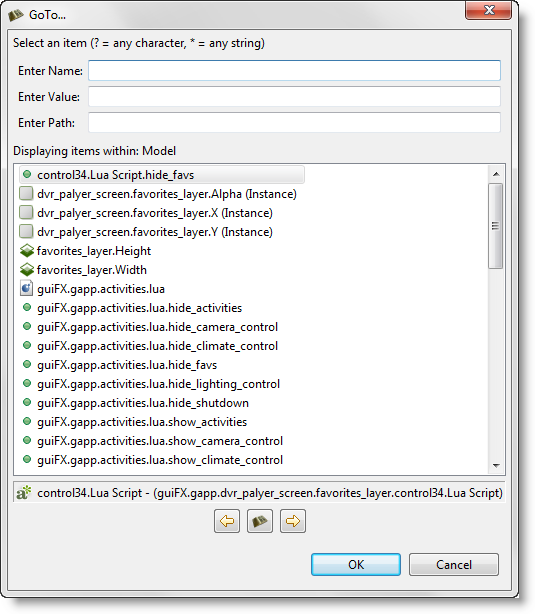
The Name, Value and Path entries allow you to narrow the search criteria for the object you wish to find. The text entered here will filter the results in the list to only display search results matching what you have typed. The drop down menu next to the text field allows you to narrow the focus of what elements are being searched for a text match:
- Name
This selection will cause the search to be limited to the primary name of the objects being searched.
- Value
This selection will cause the search to be limited to the value field of actions or render extensions being searched.
- Path
This selection will cause the search to look at the fully qualified Storyboard path of the object being searched.
Below the list there is a label which displays the location of the currently selected item. If you have a control selected, the label will display the information of the layer that control belongs to.
Another way to navigate and filter the result set is to use the left and right arrows at the bottom of the dialog. These arrows allow you to navigate through the various levels of your application.
- Left Arrow
Pressing left will jump to the place containing the current selection's parent. For example: If a control is selected and the left arrow is pressed, the list will now have the layer it belongs to selected and display everything on the screen that layer belongs to.
- Right Arrow
Pressing right will jump the objects that are contained within the current selection. For example: If a layer is selected and right is pressed, the list will now only display the controls, actions, variables, and attributes, contained within that layer.
- Home Button
Pressing the center button with the logo on it will bring you back to the list of everything in the entire model. The same effect can be achieved by going left passed the application.
Storyboard Search provides an extension of the Go To functionality. Rather than providing the ability to see and navigate to a single selection, the results of a search are displayed in a tree format.
Searching can be done by invoking the Search dialog via the Search menu item or the CTRL+H key command. This will open up the search criteria dialog
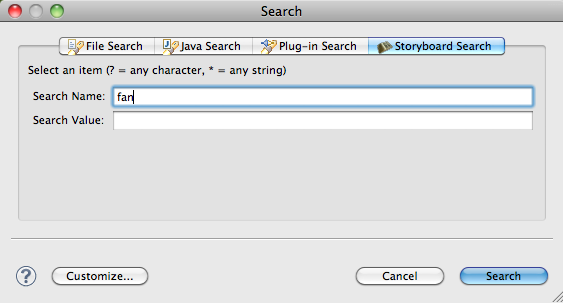
Similar to the GoTo dialog, the Name and Value search criteria allow model object names to be searched or in the case of actions and render extension arguments and variables also their values.
The search results will be displayed hierarchically in the Search view:
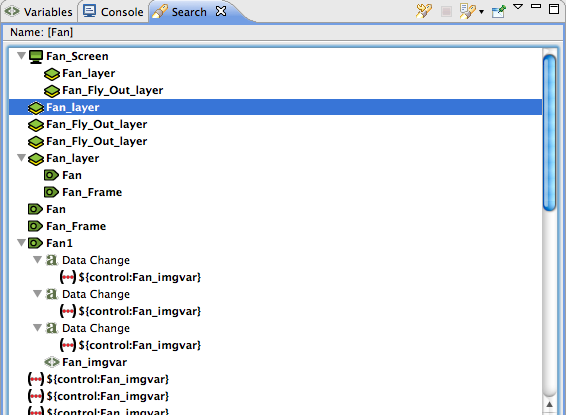
Where applicable, double clicking the results will cause the appropriate model element to be selected and brought forward in the main Storyboard editor.
The Resize Storyboard Application dialog is used create a new Storyboard Designer model file, with different screen width and height settings, based on an existing model file.
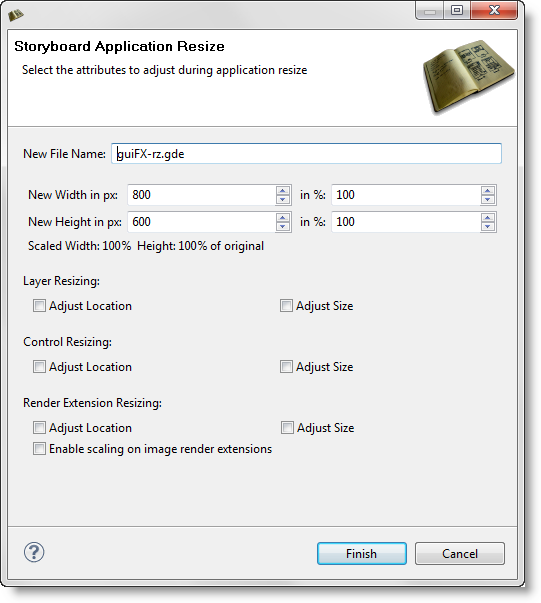
The application resize action dialog allows a Storyboard Designer model file to resize its screen dimensions. Since all of the layers, controls and render extensions in a model are placed at specific locations within the model, the resize operation provides several parameters to allow the layers, controls and rendr extensions to be either re-positioned or re-scaled as appropriate.
The output of the resize action is a new model file located in the same filesystem location as the source model file. Creating this new scaled model file next to the original model file allows the designer to validate and inspect the scaled result before deciding to replace the original file.
The Resource Clean Up wizard can be run from within the Images view or by selecting the model file in the Navigator view and selecting Resource Clean Up... from the menu.
 |
The Resource Clean Up wizard is used to remove resources that are present in the workspace but are no longer referenced by the project. In the wizard, the list on the left side contains the resources (fonts, images) and is used to select the resources that should be maintained/kept in the project. All resources that are not selected will be permanently removed from the project and filesystem. The preview on the right side contains a preview of the selected resource and the filesystem location of that resource.
This tool can only detect those resources that are directly referenced by the project. It is important that resources that are referenced from external programs or scripts be manually checked so as to prevent their removal from the project.
Once all of the resources to remove have been identified, selecting OK will perform the permanent removal of those files from the filesystem.
The Consolidate Images Wizard can be launched from the toolbar in the Images view.
 |
Launching the Consolidate Images wizard will start an analysis of all of the images in the workspace. These images are compared byte by byte to determine if their content is identical and can safely be consolidated together into a single reference.
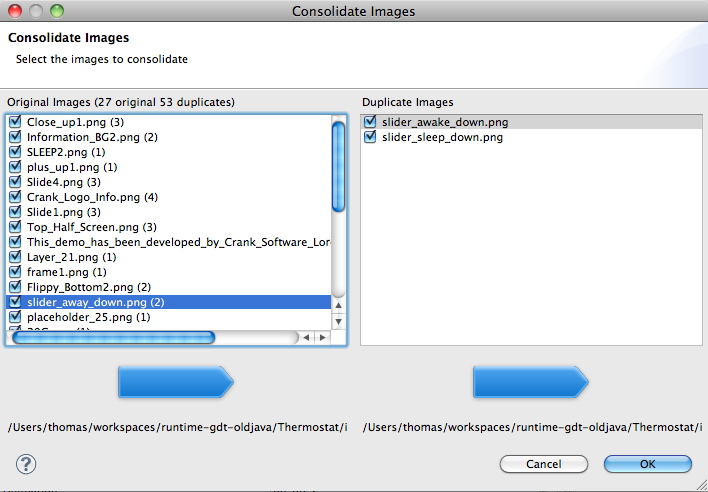 |
Once the analysis is completed, a dialog will present the results showing the duplicate images that have been detected and allowing a visual comparison of the source and reference images to ensure that they are indeed different.
By default all duplicates will be consolidated into a single reference. To remove a reference from being consolitated, uncheck the item.
Selecting OK will search the model and consolidate variable and argument references to unify their references.
 |
After all of the references have been combined there are likely to be a number of images that are no longer used. These can be immediately deleted from the workspace at this point.